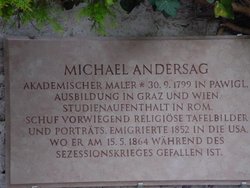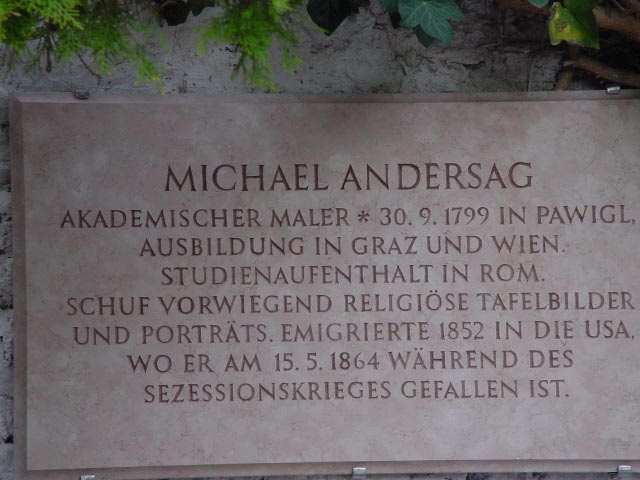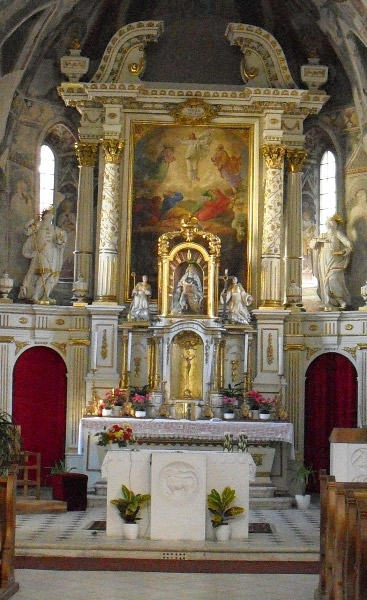He arrived in New York City aboard the ship "Woodside" from Le Havre on 2 September 1852. His plan was to become a teacher of art at the Polytechnic School in Williamsburgh (most probably the village by that name which later was incorporated as part of Brooklyn, New York). But nothing is known of his whereabouts until 14 September 1853, when he filed paperwork in Onondaga County, New York declaring his intention to become a U.S. citizen. Thereafter he lived and worked as a painter in Syracuse and became a U.S. citizen there on 7 October 1857.
He was a successful artist and well-known and well-liked in the Syracuse German community. He remained unmarried. When the Civil War broke out in 1861, Michael Andersag evidently joined the majority of his fellow Germans in responding with strong feelings about the need to fight for "freedom, liberty, and union" in his adopted country. The following year, in response to President Lincoln's second proclamation calling for troops, and despite his advanced age of 62 years, Michael Andersag enlisted as a private in the mostly-German Company B of the 149th New York Volunteer Infantry Regiment. He signed on for a three-year hitch or until the war was won, and went with the Company (including many of his friends) to fight for the Union when they left Onondaga County for points south in September. Before leaving Syracuse, he wrote a will leaving his savings and the proceeds from the sale of his paintings to support the widows and orphans of the German Civil War soldiers of Syracuse.
While away at war, Andersag wrote several letters back home to the editor of the _Syracuse Journal_, including one that was turned into an article published 5 June 1863, describing Andersag's capture around the time of the Battle of Chancellorsville, Virginia (1-3 May 1863), when many men from his regiment were killed, wounded, or captured and marched to Richmond.
Andersag's regiment, the 149th NY Infantry Volunteers, took part in the following battles during the Civil War: Chancellorsville (Virginia), Gettysburg (Pennsylvania), Wauhatchie and Lookout Mountain (Tennessee), and Ringgold, Resaca, New Hope Church, Lost Mountain, Pine Knob, Kennesaw Mountain, and Peachtree Creek in the Atlanta Campaign (Georgia). They were present at the battles of Missionary Ridge (Tennessee), Rocky Face Ridge (Georgia), and Aversboro and Bentonville (North Carolina). They also took part in General Sherman's famous "March To the Sea" from Atlanta to Savannah, Georgia. In all, 133 men died and 353 were wounded.
Andersag's unit captured four Confederate battle flags, two at the Battle of Lookout Mountain (24 November 1863 near Chattanooga, Tennessee) and two in the Battle of Ringgold, Georgia (27 November 1863). Today, three of these flags (Semple's Battery of the Alabama Light Artillery flag, 34th Mississippi Infantry flag, and 29th Mississippi Infantry flag; the fourth flag is lost) are housed in the Museum of the Confederacy in Richmond, Virginia. Each has its capture legend ("Captured by the 149th N.Y.V....") inscribed on it in gold by the hand of Michael Andersag. (See Memoirs of the 149th N.Y.V.Infantry from Capt. Geo. Collins 1891.)
But Michael Andersag did not live to come home to Syracuse from the war. On the morning of 15 May 1864, the last day of the bloody three-day battle of Resaca, Georgia, he was missing, and by that afternoon was declared fallen on the battlefield north of the Oostanaula River. A letter signed by a captain of the regiment found in his military records at the National Archives states that there were no remains of Michael Andersag since "his body was burned all to a crisp after being killed" (perhaps in a fire in a barn near the battlefield the previous day). So the "gallant old soldier" and spirited American patriot from the Tyrol still lies in the red soil northwest of Resaca, but there is no grave.
His descendants, admirers, and art scholars have erected a memorial plaque for him in the municipality of Lana in the South Tyrol which was dedicated on 15 May 2004, the 140th anniversary of his death. Meanwhile, his paintings in Europe and in the U.S. are still being cataloged and appreciated.
He arrived in New York City aboard the ship "Woodside" from Le Havre on 2 September 1852. His plan was to become a teacher of art at the Polytechnic School in Williamsburgh (most probably the village by that name which later was incorporated as part of Brooklyn, New York). But nothing is known of his whereabouts until 14 September 1853, when he filed paperwork in Onondaga County, New York declaring his intention to become a U.S. citizen. Thereafter he lived and worked as a painter in Syracuse and became a U.S. citizen there on 7 October 1857.
He was a successful artist and well-known and well-liked in the Syracuse German community. He remained unmarried. When the Civil War broke out in 1861, Michael Andersag evidently joined the majority of his fellow Germans in responding with strong feelings about the need to fight for "freedom, liberty, and union" in his adopted country. The following year, in response to President Lincoln's second proclamation calling for troops, and despite his advanced age of 62 years, Michael Andersag enlisted as a private in the mostly-German Company B of the 149th New York Volunteer Infantry Regiment. He signed on for a three-year hitch or until the war was won, and went with the Company (including many of his friends) to fight for the Union when they left Onondaga County for points south in September. Before leaving Syracuse, he wrote a will leaving his savings and the proceeds from the sale of his paintings to support the widows and orphans of the German Civil War soldiers of Syracuse.
While away at war, Andersag wrote several letters back home to the editor of the _Syracuse Journal_, including one that was turned into an article published 5 June 1863, describing Andersag's capture around the time of the Battle of Chancellorsville, Virginia (1-3 May 1863), when many men from his regiment were killed, wounded, or captured and marched to Richmond.
Andersag's regiment, the 149th NY Infantry Volunteers, took part in the following battles during the Civil War: Chancellorsville (Virginia), Gettysburg (Pennsylvania), Wauhatchie and Lookout Mountain (Tennessee), and Ringgold, Resaca, New Hope Church, Lost Mountain, Pine Knob, Kennesaw Mountain, and Peachtree Creek in the Atlanta Campaign (Georgia). They were present at the battles of Missionary Ridge (Tennessee), Rocky Face Ridge (Georgia), and Aversboro and Bentonville (North Carolina). They also took part in General Sherman's famous "March To the Sea" from Atlanta to Savannah, Georgia. In all, 133 men died and 353 were wounded.
Andersag's unit captured four Confederate battle flags, two at the Battle of Lookout Mountain (24 November 1863 near Chattanooga, Tennessee) and two in the Battle of Ringgold, Georgia (27 November 1863). Today, three of these flags (Semple's Battery of the Alabama Light Artillery flag, 34th Mississippi Infantry flag, and 29th Mississippi Infantry flag; the fourth flag is lost) are housed in the Museum of the Confederacy in Richmond, Virginia. Each has its capture legend ("Captured by the 149th N.Y.V....") inscribed on it in gold by the hand of Michael Andersag. (See Memoirs of the 149th N.Y.V.Infantry from Capt. Geo. Collins 1891.)
But Michael Andersag did not live to come home to Syracuse from the war. On the morning of 15 May 1864, the last day of the bloody three-day battle of Resaca, Georgia, he was missing, and by that afternoon was declared fallen on the battlefield north of the Oostanaula River. A letter signed by a captain of the regiment found in his military records at the National Archives states that there were no remains of Michael Andersag since "his body was burned all to a crisp after being killed" (perhaps in a fire in a barn near the battlefield the previous day). So the "gallant old soldier" and spirited American patriot from the Tyrol still lies in the red soil northwest of Resaca, but there is no grave.
His descendants, admirers, and art scholars have erected a memorial plaque for him in the municipality of Lana in the South Tyrol which was dedicated on 15 May 2004, the 140th anniversary of his death. Meanwhile, his paintings in Europe and in the U.S. are still being cataloged and appreciated.





